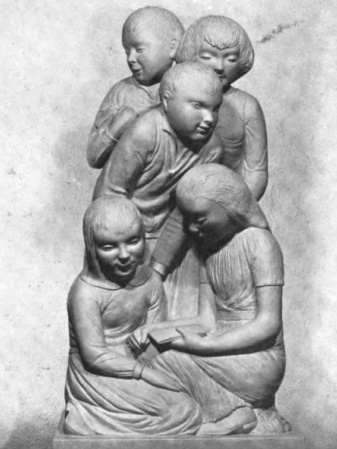("The Builders," an oil painting by Charles F. Quest (1904-1993), created while he was in the New Deal's Public Works of Art Project. Image courtesy of the Smithsonian American Art Museum.)
Like the rest of America's infrastructure, public buildings are falling apart. Let's take schools, for example: There are
failed heating systems in Baltimore, an
unrepaired roof collapse in Bridgewater, Massachusetts, and toxic plumbing in
hundreds of schools and day care centers across the country. In Detroit, teachers are
suing the school system over the decrepit conditions they have to work in, including black mold (which causes respiratory and other ailments), bacteria problems, freezing temperatures, rodent and insect infestations, unusable playgrounds and gymnasiums, broken and rotting floors, mushrooms growing out of the walls, and windows that were shot out years ago. And this is only the tip of the iceberg. According to the American Society of Civil Engineers,
$270 billion is needed for school maintenance and modernization, but national spending on schools has dropped.
Today, American public policy is very clear: Reduce infrastructure spending and hand out all manner of tax breaks, tax exemptions, tax deductions, tax credits, tax loopholes, and tax gimmicks to millionaires & billionaires. Further, protect the super-wealthy from law enforcement when they hide money in foreign bank accounts (see, e.g.,
here and
here). This pro-rich, anti-infrastructure public policy has been very effective in distributing money upward. And so, as children are forced to drink neurotoxins (lead) from old & filthy plumbing, the rich are adding
tens, even
hundreds of billions of dollars to their personal fortunes,
every single year.
Many people might not know it (since the teaching of history has been belittled in recent decades), but America's public policy was not always so demented and psychopathic. During the New Deal, massive investments were made in our nation's infrastructure. For example, the following six New Deal work agencies performed 355,000 projects to construct, repair, or improve public buildings.
Civil Works Administration (CWA): 60,500
(A CWA dairy barn project for an educational facility in Xenia, Ohio. During the New Deal, farm buildings were built for agricultural education & training. Photo from "America Fights the Depression: A Photographic Record of the Civil Works Administration," used here for educational, non-commercial purposes.)
"Of the 60,500 buildings repaired or constructed under the [CWA], over half were educational buildings" (Analysis of Civil Works Program Statistics, 1939, p. 10). Work-relief administrator Harry Hopkins wrote, "Long after the workers of CWA are dead and gone and these hard times forgotten, their effort will be remembered by permanent useful works in every county of every state. People will... attend schools they built... do their public business in courthouses and state capitols which workers from CWA rescued from disrepair..." (Spending to Save, 1936, p. 120).
Public Works Administration (PWA): 11,893
(Fort Hill High School in Cumberland, Maryland was built with PWA funds, and still serves the community today, 80 years later. The football stadium you see in the foreground was carved out by WPA workers. Photo by Brent McKee.)
PWA funds were used to construct educational buildings, hospitals, post offices, and more. Generally speaking, the PWA funded the larger building projects of the 1930s. (Robert D. Leighninger, Jr., Long Range Public Investment: The Forgotten Legacy of the New Deal, 2007, p. 88)
Work Division of the Federal Emergency Relief Administration (FERA): 46,231
(A new tuberculosis hospital in Mayaguez, Puerto Rico, constructed with funding from FERA, ca. 1934. Photo from a FERA report.)
Public buildings constructed, repaired, or improved through FERA included firehouses, armories, city garages, and historical buildings. (The Emergency Work Relief Program of the FERA, April 1, 1934 - July 1, 1935, 1935, pp. 32-38)
Works Progress Administration (WPA): 125,110
(Many of the WPA's structures are still with us today, like this town hall in Williamsport, Maryland. Photo by Brent McKee.)
Between 1935 and 1943, WPA workers built, repaired, or improved schools, libraries, health facilities, state capitols, warehouses, gymnasiums, museums, city halls, and much more. (Final Report on the WPA Program, 1935-43, 1946, pp. 131 and 135)
Civilian Conservation Corps (CCC): 76,179
(A CCC-built lodge at Cacapon State Park in West Virginia. Photo by Brent McKee.)
In parks & forests across the nation, the CCC boys built cabins, shelters, bathhouses, barns, and more. Many of the CCC's structures are still used by the public today. A year or so ago, a man contacted me and asked me if he could use the photo above because he and his fiance were having their wedding in the building. I said "yes," of course. In keeping with the public spirit of the these buildings, anyone can feel free to use photos I take of New Deal sites and structures. (Federal Security Agency, Final Report of the Director of the Civilian Conservation Corps, April , 1933 through June 30, 1942, ca. 1943, p. 105)
National Youth Administration (NYA): 35,180
(An NYA-built faculty house at Bethune-Cookman College, Daytona Beach, Florida, 1943. Photo courtesy of the Library of Congress.)
Enrollees in the NYA engaged in the same types of building projects as the other New Deal agencies. And, like the CCC, these projects were meant not only for public use, but also to teach young Americans carpentry, masonry, plumbing, etc. Many people today would label these activities, "godless communism." But I would call it a very good way to engage our youth in productive activities, especially when you consider the unbelievably
high rates of unemployment that young Americans must cope with. (Federal Security Agency, War Manpower Commission,
Final Report of the National Youth Administration, Fiscal Years 1936 - 1943, 1944, pp. 139)




























